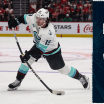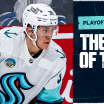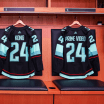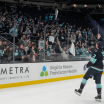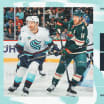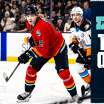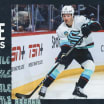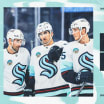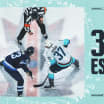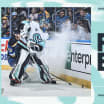SEATTLE -- Anyone who doesn't see the fun in data and statistics would think again if attending Wednesday night's "Hockey Analytics: The Numbers Behind the Game" discussion at the Pacific Science Center's IMAX theater. NHL Seattle's hockey operations brain trust entertained a packed house of more than 300 people who laughed, hooted a bit and went wall-to-wall with engaging queries during the Q-and-A portion of program.
The team's general manager, Ron Francis, suggested early in the panel discussion that fans will be able to follow along from the first building blocks of the roster to opening night in the fall of 2021. He was joined on stage by assistant GM Ricky Olczyk, director of hockey administration Alexandra Mandrycky and the night's moderator, former voice of Seattle Sounders FC and sports commentator, Ross Fletcher.
Mirth in the Numbers
NHL Seattle's hockey leaders educate and entertain community about analytics and hockey math at Pacific Science Center series
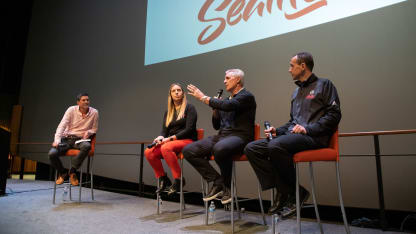
Unlike the existing 31 NHL teams with many seasons of stats and player evaluations, Francis explained "we're going into this with nothing, starting from scratch with the data and scouting reports."
"When we start getting the data and information, as Alex says, then we can start having fun," said Francis, smiling.
Turns out Sept. 25 was a fitting day for a data-driven discussion, part of a continuing "The Science of Sports & Entertainment" series at Pacific Science Center. Earlier in the day, the team announced the hiring of five pro scouts to kick-start the process. The crowd cheered extra hard when Cammi Granato was identified as one of the hires and the NHL's first female pro scout.
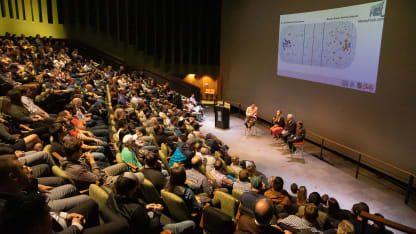
Francis assured the crowd that Granato's appointment was "all about her resume," which includes captaining a gold-medal U.S. Olympic team, playing in every women's hockey World Championship from 1990 to 2005 and being inducted into the Hockey Hall of Fame in 2010. The hockey world's top experts seconded the notion all day Wednesday with hundreds of tweets affirming Granato's qualifications for the position.
At Fletcher's behest, Mandrycky paved historic groundwork for the night. She reviewed that assists on goals were first counted as official hockey statistics in 1918, "a little bit before Ron started playing." As the crowd chuckled, Olczyk feigned disagreement by interjecting, "check the record books!" More laughs. It is a positive thing to see such easy rapport among the team's hockey operations or "hockey ops" leaders.
Secondary assists were introduced in 1936 and Mandrycky deftly made the case for what she called "hockey's first advanced stat" by explaining that those assists go deeper into how a goal is scored. You don't just know who made the last pass before the goal, starting in 1936, you were better informed about a third player who potentially set up the goal.
Starting with this simple example, the audience could begin to piece together how getting more data about how goals are scored is vital to forming a winning team and evaluating individual players. More history from an informative slide on the IMAX screen: In 1955, all team shots on goal were recorded but not assigned to individual players until 1997, when the NHL also started tracking such stats as faceoff wins, body checks and time on ice for each player in every arena, every game. In 2005, the league added missed and blocked shots plus giveaways and takeaways to give fans more material to make their own evaluations of favorite teams and players.
The panel discussion revealed a distinct and momentous upturn in hockey "analytics" or the practice of data science over the last five NHL seasons. Olczyk explained the advanced stats of hockey analytics are routinely part of the back-and-forth of contract discussions with player agents. Mandrycky pointed out that Francis was one of the first front office executives to hire a full-time analytics person in 2014.
Francis said he embraces analytics "as another layer of security in making your decision."
You want to get as much information and background as you can for a player," said Francis. "Analytics are a key part of the process in evaluating players, making decisions to build a roster and making trades."
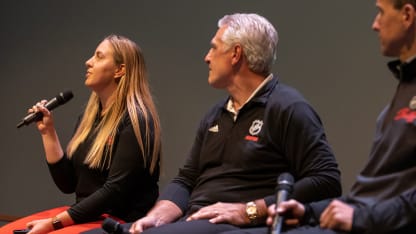
Francis and Mandrycky agreed it is important for NHL Seattle to build out its standards and practices for data collection and analysis. Mandrycky noted the difference between collecting data "not just on creating shots but how players create the shots."
Francis took the rapt audience through an exercise: Imagine two of your team's players are bearing down in the offensive zone with the puck. There is a lone defenseman trying to stop your players from taking a shot on goal, manned by a goaltender. That's what's known as a 2-on-1 in hockey.
"One of the players takes a good shot on goal … is that a scoring chance?"
Lots of hands go up.
"OK, same play, but the shot is wide of the net … is that a scoring chance?
A healthy show of hands but less than before.
"Some coaches do not consider that a scoring chance. And what if the defenseman deflects the shot off goal? Is that a scoring chance?"
Francis answered his question: "Some would say yes. As an organization, we will determine our analytics approach [on how to log scoring chances and much more]."
Mandrycky was buoyant when Fletcher asked about the potential of player and puck tracking that is scheduled to begin supplying data to NHL clubs (Seattle included) for the 2020 playoffs next spring.
Francis wryly posed his own question to Fletcher: "Did you not see Alex's face light up when you mentioned player and puck tracking?" More smiles from the crowd.
The system will literally track the movement of the puck and actions of all players via microchips and strategically positioned cameras in NHL arenas. Embedding chips in pucks that still satisfied players and coaches about the puck's feel and performance took years of trial and error. Chips in the player jerseys will be unobtrusively sewn in the back of jerseys at the neckline.

As Mandrycky explained recently, the league has been supplying about 300 "data events" per game. Using a sports software data service (the vendors are typically startups and vary by team) can produce about 3,000 data points per game. Puck and player tracking will jump the number to 3,000 data outcomes per second of game action. The math: 3.6 million data events per 20-minute period or almost 11 million each game night. Whew.
Mandrycky said as an analytics person she has many conversations with coaches and management about a certain player's scoring ability that might stall when a coach or manager asks, "what about the defender, do we know how it impacted the defender, what he was doing?"
"With puck and player tracking, I'm excited to be able to say I actually do know how it impacted the defender," said Mandrycky. "There will be a lot less ability to say what we don't know. It will take a lot of time but you can see how tracking in baseball and basketball and football now have revolutionized the sport and improved the product for fans."
What data teams mine from the puck and player tracking and how the numbers are crunched will be critical to the work of using analytics to build winning rosters and hoisting the Stanley Cup. No matter the 32 ways it will be done in the NHL, there will be an upside for all fans.
"Puck and player tracking will tell you the speed a player is skating, velocity of passing the puck, shot speed," said Francis. "There are lots of different things happening in the course of a game. You might not realize that last shot was 93 miles per hour but you might be watching a game and see that stat. It will be exciting for fans to see all of those numbers. It will make the game more enjoyable."

